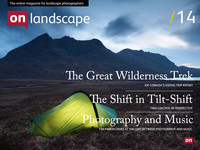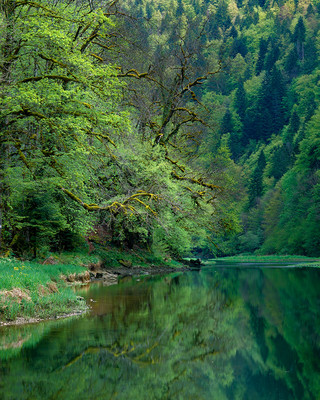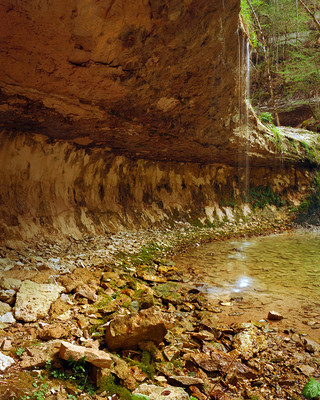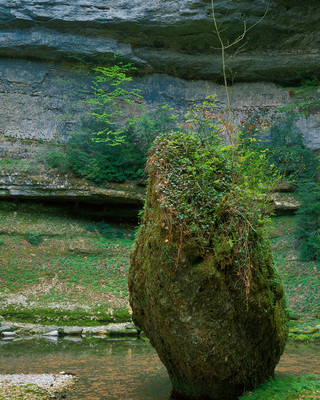Julian Barkway asks if there is more

Julian Barkway
Iam what can best be described as an enthusiastic amateur photographer. I try not to follow fashion or trends and I’m never happier than shooting with my 5x4 camera on good old sheet film. The intimate landscape is what interests me which is, perhaps, surprising given that I have been based in Switzerland for a number of years. My favoured habitat is the bottom of a rocky gorge but I do occasionally emerge to shoot the bigger vista. And I do occasionally shoot digital - but shhh, don’t tell anyone! website
What is 'beauty' in landscape photography? On the face of it, it's almost a question that doesn't even need to be asked. We all know intuitively what a beautiful landscape looks like, don't we? But is it so intuitive? And what makes the landscape 'beautiful'? Why do we respond better to certain types of terrain and not others? Is the landscape intrinsically beautiful or are we looking at it through the prism of our own experiences and cultural associations? And why is this even important? Well, beauty is undeniably fundamental to good composition - we try to arrange the elements of our photograph in an aesthetically pleasing way, do we not? - so understanding our perception of beauty is a key part in transferring our vision of the landscape to a meaningful photograph. To do this we first need to analyse how 'beauty', or more generally, 'aesthetics', relate to photography.
I often travel to relatively remote mountain areas to make photographs and it was during one such trip that I found myself musing on why wilderness is such a powerful draw in landscape photography. I didn't need to search much further than my own feelings of elation and well-being whilst enjoying the mountains to find the answer. But this came far too easily to be truly satisfying and I was left with the feeling that there must be more to it than that. Let's try framing the question in a different way: is there something profound in the human psyche that makes the experience of wilderness so alluring? Or is this a comparatively recent phenomenon? If we look back to the pre-industrialised world, to a time when mankind was much more a part of nature, wild nature was something to be feared. Crossing a mountain pass was so fraught with all kinds of dangers - some natural, some arising from unfriendly or downright malignant locals - that it was only ever done out of absolute necessity. In addition to these perils, the harshness of daily life gave people little time for travel or reflection. When you have to struggle with nature on a daily basis you have an entirely different relationship with it.
Then came 19th century industrialisation and the urbanised lifestyle that went with it. People began to find themselves increasingly cut off from the natural world so, partly in response to this, poets and novelists, belonging to what became known as the Romantic movement, were busily imbuing the landscape with distinctly human qualities - we need look no further than the novels of Thomas Hardy for evidence of this. Artists as diverse as Constable and Turner were depicting the landscape as a sort of bucolic fantasy or as a dramatic turmoil of the elements. At the same time, the quickly improving transportation infrastructure was allowing greater access to areas which were previously considered to be far too dangerous. And shortly before the turn of the last century, our relationship with landscape had changed so much that Sir Arthur Conan Doyle was thrilling readers of 'The Strand' magazine with tales of his exploits as an early Alpine skiing enthusiast in Switzerland. Wilderness had started to become exciting, interesting and alluring. People had more free time and were increasingly taking advantage of better transport links to travel.
These days we can visit wilderness in comparative comfort and safety so, more than ever before, wilderness is symbolic of freedom and reconnecting with a lifestyle we have largely lost. Above all, being in a wild place gives us pause for thought. We think about our place in nature, the fragility of life, how small we are in comparison to the vast landscape. We might even see ourselves as akin to explorers, happening on a wilderness for the first time. It's these attitudes and associations which drive our fascination with nature in the raw.
So when we talk of 'capturing the beauty of nature' or 'capturing mood and emotion', what do we really mean? Are we simply responding to cultural associations? Is beauty there just waiting to be captured by our cameras or is it created by the act of making an image? Can nature be intrinsically beautiful? To this last I would answer, no it can't. And neither is it intrinsically ugly. Nature just 'is'. For example, a flower looks the way it does to serve a purpose - that of attracting insects for pollination - it's just coincidence that we humans also find most flowers sensually attractive. Similarly, a pristine landscape is fundamentally the product of the quantifiable and deterministic forces acting on its underlying rock and, as with the flower, humans are simply an irrelevance. In the same vein, can nature really be moody and emotional? Of course not. A stormy sea, for example, is caused, as we know, by high winds which are in turn a product of the rotation of the Earth and the effects of the Moon and our local star, the Sun. Even at a smaller scale, nature has evolved forms which, after millennia of natural selection, are the most efficient and energy-saving for the jobs they have to do. Even if, like a mathematical equation reduced to its simplest and most concise expression, we humans perceive such things as 'beautiful'.
Human vision systems contain, by a long way, the best pattern-recognition 'algorithms' of which we know. We are pre-programmed to seek order in the essential chaos of nature; to look for patterns and symmetry since this is what makes the world around us so much easier for our brains to assimilate. When these symmetries are not readily apparent, the task of our visual cortices becomes much harder and this extra effort required is reflected in feelings of uncertainty, disorientation or a vague sense of unease - feelings that are not present when what we see can be understood more effortlessly. After all, a scene which we do not readily understand may contain hidden dangers so such feelings of unease would, in more primitive times, be a necessary survival strategy. But it isn't just pattern and symmetry that we find attractive. There is also shape and form. Down through the ages, artists have associated a preference within all of us for curving, bulbous shapes with the female body and, in particular, that part of it which is bound up with our earliest tactile sensations.
By making images of the landscape, we are doing two things: we are placing a frame around a part of nature which contains, at the most basic level, an arrangement of forms which the human mind finds easy to process - Modernist reductivism, if you like. But, at the same time, we are also essentially photographing a metaphor. A stormy sea is not inherently emotional but seeing such a scene does trigger a slew of associations - vulnerability, emotional turbulence, awe, excitement, which, if the photographer is doing their job properly, is perceived by the viewer as emotion - the Romantic approach. There is no hard and fast dividing line between these two strands of landscape photography and they are not mutually exclusive. Thus, on one level, beauty in landscape photography is about how we arrange nature and what shapes or forms we choose to photograph and on another, about the meaning, or semantics, of those forms and patterns.
It isn't just a matter of choosing a subject which is rich with associations, though. Colour has a very large part to play as well. Colour theory tells us, amongst other things, about the emotional associations of individual colours and intensities. We all know there are 'warm' and 'cool' colours (reds, yellows and oranges vs. blues and greens) which are clearly associated with such 'elements' as fire, water or ice. Strongly saturated 'warm' colours are associated with heightened emotional states while the 'cooler' end of the spectrum puts us in mind of calmness and contemplation. The same can be said of highly saturated colours as opposed to pastels. Strongly contrasting colours lead to visual confusion whereas toning colours have an inclusive effect; bringing disparate elements together in an unforced way.
When we photograph, say, a sunset over the ocean we are essentially playing with layers of metaphor and association, allbeit in a very obvious way. Think about it. The ocean represents our own smallness in relation to nature. A gently lapping sea evokes tranquility; a rough one, excitement and drama. In the sky, warm colours reflected from clouds are associated with feelings of contentment and security while the cool blues of the sky and the ocean underline these feelings with a sense of calm. In such a scene, our experience of 'beauty' is essentially a product of the pleasant sensations which the scene evokes.
Of course, I'm not saying that you should go around consciously trying to play with metaphor or associations in every image you make. Some subjects are obviously more amenable to this approach than others. However, it can be a useful tool if your aim is to add layers of meaning to your work. Similarly, reducing every scene to its simplest expression can work well but that doesn't mean that showing the raw complexity of nature isn't also valid. Understanding the 'tools of the trade' is what it's all about. Not just the physical tools with which we capture, store and process our images but also the mental toolkit of ideas and aesthetics which we all take with us into the field and employ before we have even triggered the camera's shutter.
If we are to make images which go beyond merely providing the sensation of 'beauty' in an obvious way, we need to be aware of how we perceive it. Formal composition distills the chaos of nature to the barest essentials revealing form and structure; associations of form and colour evoke emotions and, on top of all of this, our cultural associations help to finely tune those emotions. Not that we are aware of any of this when we view an image - it all happens at too deep a level - but if we take control of these aspects when we place a frame around a segment of the wider landscape then we might just end up making subtler, more evocative and more finely-nuanced images, and perhaps even go 'beyond beauty'.




